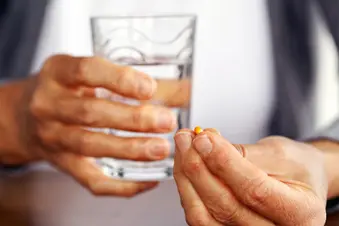
When you have autosomal dominant polycystic kidney disease (ADPKD), fluid-filled cysts grow inside your kidneys. There’s no cure for this genetic disease, but some treatments can make living with it easier.
At least one drug may slow disease progression in some people. Other medicines can treat the conditions that often occur with ADPKD. You may also get symptom relief from a range of nondrug treatments.
Tolvaptan for ADPKD
The drug tolvaptan is sold under the brand names Jynarque and Samsca. But only Jynarque can treat ADPKD. If your disease is likely to worsen quickly, Jynarque may help your kidneys do their job longer.
Your doctor will watch you for liver problems with this drug. You can expect frequent blood tests in the beginning. After a while, you’ll need them about every 3 months.
Other side effects from tolvaptan include:
- Thirst
- Peeing a lot
- Making large amounts of urine
- Waking up at night to pee
Blood Pressure Treatments
High blood pressure, also called hypertension, is a common symptom of ADPKD. It usually affects you early in the disease.
It can make heart problems more likely and cause your ADPKD to move faster. Early treatment may help prevent heart problems and slow the growth of cysts.
The most common types of blood pressure medicine for people with ADPKD are ACE inhibitors and angiotensin-2 receptor blockers (ARBs).
Painkillers for ADPKD
Pain, like high blood pressure, is one of the most common ADPKD symptoms. Depending on the cause and location of your pain, one or more of these might be right for you.
- Acetaminophen. For short term pain, this is safe for people with kidney problems.
- Opioids. When acetaminophen doesn’t work well enough, your doctor may suggest an opioid painkiller. Tramadol (Ultram) is often prescribed for ADPKD.
- Anti-seizure medications. These drugs, also called anticonvulsants, can ease chronic pain caused by nerve damage. Examples include gabapentin (Neurontin) and pregabalin (Lyrica).
- Antidepressants. Some medicines that treat depression can also ease chronic pain.
In general, people with kidney problems should avoid nonsteroidal anti-inflammatory drugs (NSAIDs) such as ibuprofen and naproxen. They can damage your kidneys and stop blood pressure medications from working.
Antibiotics
Antibiotics treat some of the painful infections that often occur with ADPKD. These include:
- Urinary tract infections (UTIs). ADPKD makes you more likely to get upper urinary tract infections. They can cause fever and pain in your side.
- Kidney infections. ADPKD also raises your risk for a type of kidney infection called acute pyelonephritis. It’s a bacterial infection that, like a UTI, causes fever and side pain. In addition, cysts themselves can become infected.
Antibiotics can cure these infections, which gets rid of the pain they cause.
Kidney Stone Treatment
About 25% of the people with ADPKD also get kidney stones. They can be extremely painful. Sometimes they can block urine without any symptoms. One way or another, kidney stones have to pass out of your body to prevent long-term kidney damage.
Small stones may pass when you pee, but there are things you can do to make the process go faster.
- Drink a lot of fluids.
- Take alpha-blockers (medicines to help stones pass).
- Don't eat salt or salty foods.
Your doctor may suggest a more aggressive approach for a large kidney stone.
- Shock wave therapy uses energy waves to break the stone into small pieces so it can pass.
- Surgery can remove or break up the stone.
Surgery
When drugs aren’t enough to control your pain -- or when your disease is very advanced -- you and your doctor may discuss surgical options. These may include:
- Cyst aspiration. Draining cysts with a needle is the least invasive surgical option, but don’t expect long-term pain relief. Roughly a third of people who get cyst aspiration for ADPKD are pain free after 18 months.
- Cyst fenestration. This surgery uses cuts to drain kidney cysts. Results tend to last longer than with cyst aspiration, but it still isn’t a long-term pain solution.
- Nephrectomy. When your ADPKD is very severe, nephrectomy -- surgical removal of a kidney -- may be recommended for pain relief.
- Kidney transplant. Removal and replacement of a kidney transplant is an option if your kidneys fail. It takes a while to arrange. You need an evaluation by the medical team at a transplant center. If approved, you’ll be added to the national organ transplant waiting list.
Dialysis
This is also an option for kidney failure. In dialysis, you’ll be hooked up to a machine that cleans waste products from your blood. Once you begin dialysis treatments, you’ll need them for the rest of your life -- or unless you get a transplant.
Show Sources
Photo Credit: artpipi / Getty Images
SOURCES:
NHS: “Autosomal dominant polycystic kidney disease,” “Kidney stones.”
PKD Foundation: “First treatment for ADPKD is approved,” “Transplant.”
Medscape: “Tolvaptan (Rx).”
Li, X. Polycystic Kidney Disease, Codon Publications, 2015.
Advances in Chronic Kidney Disease: “Evaluation and Management of Pain in Autosomal Dominant Polycystic Kidney Disease.”
American Family Physician: “Diagnosis and Treatment of Acute Pyelonephritis in Women.”
UpToDate: “Patient education: Polycystic kidney disease (Beyond the Basics).”
National Organization for Rare Disorders: “Autosomal Dominant Polycystic Kidney Disease.”
Magyar Urologia: “Fenestration of renal cyst.”
